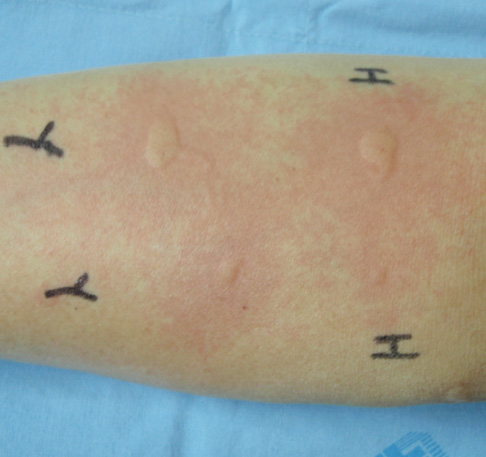Allergy Asthma Immunol Res.
2010 Apr;2(2):149-152. 10.4168/aair.2010.2.2.149.
A Case of Anaphylaxis After the Ingestion of Yacon
- Affiliations
-
- 1Department of Internal Medicine, Gyeongsang National University School of Medicine, Jinju, Korea. dr202202@yahoo.co.kr
- 2Institute of Health Science, Gyeongsang National University School of Medicine, Jinju, Korea.
- KMID: 2260603
- DOI: http://doi.org/10.4168/aair.2010.2.2.149
Abstract
- Anaphylaxis is a potentially life-threatening systemic allergic reaction, often with an explosive onset; the symptoms range from mild flushing to upper respiratory obstruction, with or without vascular collapse. Foods are common offending allergens and remain the leading cause of outpatient anaphylaxis in most surveys. Yacon (Smallanthus sonchifolius) is a plant native to the Andes region, where its root is cultivated and consumed mainly as food. Unlike most edible roots, yacon contains large amounts of ructooligosaccharides. Traditionally, yacon tubers have been used as a source of natural sweetener and syrup for people suffering from various disorders. We report the case of a 55-year-old woman who developed syncope and generalized urticaria after ingesting yacon roots. The patient had positive skin prick and intradermal tests to yacon extract. An open food challenge test was performed to confirm food anaphylaxis and was positive 10 minutes after the consumption of yacon roots. To our knowledge, this is the first reported case of anaphylaxis after the ingestion of yacon roots.
Keyword
MeSH Terms
Figure
Cited by 1 articles
-
Overview of anaphylaxis in Korea: diagnosis and management
Gwang Cheon Jang, Yoon-Seok Chang, Sun Hee Choi, Woo-Jung Song, Soo-Young Lee, Hae-Sim Park, Hye-Ryun Kang, Yeong-Min Ye, Hyun-Jung Jin, Mi Yong Shin, Soo-Jin Lee, Hye One Kim, Jihyun Kim, Jae-Woo Jung, Hee-Bom Moon, Youngmin Ahn
Allergy Asthma Respir Dis. 2013;1(3):181-196. doi: 10.4168/aard.2013.1.3.181.
Reference
-
1. Kin SJ, Jung JH. Study on development of South American roots. Report of horticultural laboratory (department of vegetable). 1986. 99–101.2. Genta S, Cabrera W, Habib N, Pons J, Carillo IM, Grau A, Sánchez S. Yacon syrup: beneficial effects on obesity and insulin resistance in humans. Clin Nutr. 2009. 28:182–187.3. Chen H-L, Lu Y-H, Lin J Jr, Ko L-Y. Effects of fructooligosaccharide on bowel function and indicators of nutritional status in constipated elderly men. Nutr Res. 2000. 20:1725–1733.4. Expert Panel on Detection, Evaluation, and Treatment of High Blood Cholesterol in Adults. Executive Summary of The Third Report of The National Cholesterol Education Program (NCEP) Expert Panel on Detection, Evaluation, And Treatment of High Blood Cholesterol In Adults (Adult Treatment Panel III). JAMA. 2001. 285:2486–2497.5. Valentová K, Moncion A, de Waziers I, Ulrichová J. The effect of Smallanthus sonchifolius leaf extracts on rat hepatic metabolism. Cell Biol Toxicol. 2004. 20:109–120.6. Pedreschi R, Campos D, Noratto G, Chirinos R, Cisneros-Zevallos L. Andean yacon root (Smallanthus sonchifolius Poepp. Endl) fructooligosaccharides as a potential novel source of prebiotics. J Agric Food Chem. 2003. 51:5278–5284.7. Geyer M, Manrique I, Degen L, Beglinger C. Effect of yacon (Smallanthus sonchifolius) on colonic transit time in healthy volunteers. Digestion. 2008. 78:30–33.8. Lachman J, Fernández EC, Orsák M. Yacon [Smallanthus sonchifolia (Poepp. et Endl.) H. Robinson] chemical composition and use-a review. Plant Soil Environ. 2003. 49:283–290.9. Valentová K, Ulrichová J. Smallanthus sonchifolius and Lepidium meyenii - prospective Andean crops for the prevention of chronic diseases. Biomed Pap Med Fac Univ Palacky Olomouc Czech Repub. 2003. 147:119–130.10. Valentová K, Sersen F, Ulrichová J. Radical scavenging and anti-lipoperoxidative activities of Smallanthus sonchifolius leaf extracts. J Agric Food Chem. 2005. 53:5577–5582.11. Seminario J, Valderrama M, Manrique I. El yacón: fundamentos para el aprovechamiento de un recurso promisorio. 2003. Lima, Perú: Centro Internacional de la Papa (CIP), Universidad nacional de Cajamarca, Agencia Suiza Para el Desarrollo y la Cooperación (COSUDE);60.12. Genta SB, Cabrera WM, Grau A, Sánchez SS. Subchronic 4-month oral toxicity study of dried Smallanthus sonchifolius (yacon) roots as a diet supplement in rats. Food Chem Toxicol. 2005. 43:1657–1665.13. Valentová K, Stejskal D, Bartek J, Dvorácková S, Kren V, Ulrichová J, Simánek V. Maca (Lepidium meyenii) and yacon (Smallanthus sonchifolius) in combination with silymarin as food supplements: in vivo safety assessment. Food Chem Toxicol. 2008. 46:1006–1013.14. Adkinson NF Jr, Bochner BS, Busse WW, Holgate ST, Lemanske RF Jr, Simons FE. Lieberman PL, editor. Anaphylaxis. Middleton's Allergy Principles & Practice. 2009. 7th ed. Philadelphia: Elsevier Inc.;1027–1049.15. Sampson HA, Mendelson L, Rosen JP. Fatal and near-fatal anaphylactic reactions to food in children and adolescents. N Engl J Med. 1992. 327:380–384.16. Vadas P, Gold M, Perelman B, Liss GM, Lack G, Blyth T, Simons FE, Simons KJ, Cass D, Yeung J. Platelet-activating factor, PAF acetylhydrolase, and severe anaphylaxis. N Engl J Med. 2008. 358:28–35.17. Simons FE, Frew AJ, Ansotegui IJ, Bochner BS, Golden DB, Finkelman FD, Leung DY, Lotvall J, Marone G, Metcalfe DD, Müller U, Rosenwasser LJ, Sampson HA, Schwartz LB, van Hage M, Walls AF. Risk assessment in anaphylaxis: current and future approaches. J Allergy Clin Immunol. 2007. 120:1 Suppl. S2–S24.18. Wang J, Sampson HA. Food anaphylaxis. Clin Exp Allergy. 2007. 37:651–660.19. Sicherer SH, Sampson HA. 9. Food allergy. J Allergy Clin Immunol. 2006. 117:2 Suppl Mini-Primer. S470–S475.
- Full Text Links
- Actions
-
Cited
- CITED
-
- Close
- Share
- Similar articles
-
- The Spermatogenic Effect of Yacon Extract and Its Constituents and Their Inhibition Effect of Testosterone Metabolism
- A case of parsely dependent sxercise-induced anaphylaxsis
- Wheat - Dependent Exercise-Induced Anaphylaxis Occurred With a Delayed Onset of 10 to 24 hours After Wheat Ingestion: A Case Report
- Wheat-dependent, Exercise-induced Anaphylaxis: A Successful Case of Prevention with Ketotifen
- A case of food-dependent exercise-induced anaphylaxis developed only in winter



